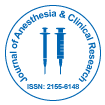
Anesthesia & Clinical Research
Open Access
ISSN: 2155-6148

ISSN: 2155-6148
Short Communication - (2021)Volume 12, Issue 8
The composition, hemostatic mechanism, hemostatic performance, research status and clinical application of absorbable oxidized regenerated cellulose hemostatic materials are briefly reviewed, and the development trend of absorbable oxidized regenerated cellulose hemostatic materials is prospected.
Absorbable hemostatic; Oxidized regenerated cellulose; Hemostatic effect; Hemostatic mechanism
Cellulose is the most abundant renewable resource in nature, and its applications involve new materials, chemical raw materials, food, medicine, environment and other fields. It has shown great development prospects in drug controlled release technology, immobilization technology, biosensors, membrane materials, carrier materials, functional chemicals and additives. As a kind of cellulose derivatives, oxidized cellulose has the characteristics of good biocompatibility, biodegradability, environmental friendliness and non-toxicity. Oxidized cellulose has been widely used in many industries. Such as the medical industry, as medical absorbable hemostatic gauze, medical absorbable surgical sutures, medical anticoagulants, oral drugs for the treatment of chronic renal failure, artificial organ materials, blood separation membranes, blood pumps, etc. In the tobacco industry, as a substitute for natural tobacco. It can also be used to prepare activated carbon raw materials, photographic paper ion exchange materials, and so on. This article reviews the clinical application of oxidized regenerated cellulose as a hemostatic material.
Hemostatic mechanism of oxidized cellulose and oxidized regenerated cellulose
Oxidized cellulose (OC) is an absorbable local hemostatic material with the appearance and texture of cotton yarn. Oxidized cellulose is made from cotton fiber oxidized by nitric oxide. The hemostatic mechanism is that the acidic carboxyl group combines with Fe3+ in hemoglobin to form a brown gel mass, which seals the end of capillaries to stop bleeding. Oxidized regenerated cellulose (trade name: Surgicel) has the same hemostatic mechanism as oxidized cellulose, and both have good tissue compatibility, soft and thin. It is easy to pack, apply, stuff, etc. After close contact with the wound, blood coagulation components can gather around it, and hemostasis can be completed in 2-8 minutes. Because of its absorbability, it is often used for bleeding on surgical wounds and areas where bleeding is not easy to stop, such as bleeding on the bone surface [1-3].
Hemostatic properties of oxidized cellulose and oxidized regenerated cellulose
The fibers of oxidized regenerated cellulose and oxidized cellulose are loose, and the body absorbs quickly, which may cause re-bleeding. The use of oxidized regenerated cellulose in general surgical models can obtain good hemostatic effects [4]. Since the acidity of these two fiber materials can destroy the hemostatic effect of thrombin, the simultaneous application cannot exert the hemostatic effect [5]. Found in the formation of neuropathy that the highly acidic environment produced by oxidized cellulose can cause nerve damage through a diffuse chemical mechanism, and the neurotoxicity caused by it is at the pH of the medium = 7.42. Will disappear. This experimental result suggests that the acidity of oxidized cellulose may cause nerve fiber degeneration, so direct use of large amounts of oxidized cellulose on peripheral nerves should be avoided. The absorption time of oxidized cellulose and oxidized regenerated cellulose depends on the dosage, the amount of blood absorbed, and the nature of the local tissue, generally 3 to 6 weeks [6]. Oxidized cellulose has strong water absorption, and moisture will reduce its hemostatic effect, so gloves and equipment should be kept dry and smooth during use [7].
Clinical application of oxidized regenerated cellulose
The soluble hemostatic gauze currently used in clinical practice, also known as instant yarn oxidized regenerated cellulose, is a kind of regenerated oxidized fiber woven yarn block, which belongs to the carboxymethyl cellulose hemostatic material [8,9]. The oxidized regenerated cellulose dissolves rapidly at the contact point 10 seconds after application, and the bleeding on the wound surface gradually decreases to stop turning into colloid within 1 to 3 minutes, and the adhesive force becomes stronger at this time. But it has poor adhesion to active bleeding wounds. The length of the hemostasis time is related to the amount of bleeding on the wound, the amount of bleeding, the location of the wound, and individual differences. Relevant research results show that there is no rebleeding, oozing, infection, liquefaction and foreign body reaction in wounds and wounds observed after using oxidized regenerated cellulose, no redness, swelling, induration and rash around, no special drainage wound and drainage fluid. The skin area was opened in two weeks, and it was found that the area where the oxidized regenerated cellulose was applied was better than the area covered by the traditional petroleum jelly gauze, and the epidermis was healed and smooth. It has no obvious effect on the healing of surgical wounds, and no adverse reactions such as allergies and infections have been found [10-13]. However used oxidized regenerated cellulose to stop bleeding during laparoscopic gynecological surgery, and then showed signs and symptoms similar to abscesses. In this case, computed tomography is challenging [14].
Oxidized regenerated cellulose has a wide range of sources and high biocompatibility, and has become a wound hemostatic material trusted by clinicians. However, its actual hemostatic effect and safety in surgical operations such as colon cancer still need more research to confirm.
Citation: Lao J, Deng W (2021) Research Progress of Absorbable Oxidized Regenerated Cellulose Hemostatic Materials. J Anesth Clin Res. 12: 1017.
Received: 12-Aug-2021 Accepted: 27-Aug-2021 Published: 03-Sep-2021 , DOI: 10.35248/2155-6148.21.12.1017
Copyright: © 2021 Lao J, et al. This is an open-access article distributed under the terms of the Creative Commons Attribution License, which permits unrestricted use, distribution, and reproduction in any medium, provided the original author and source are credited.